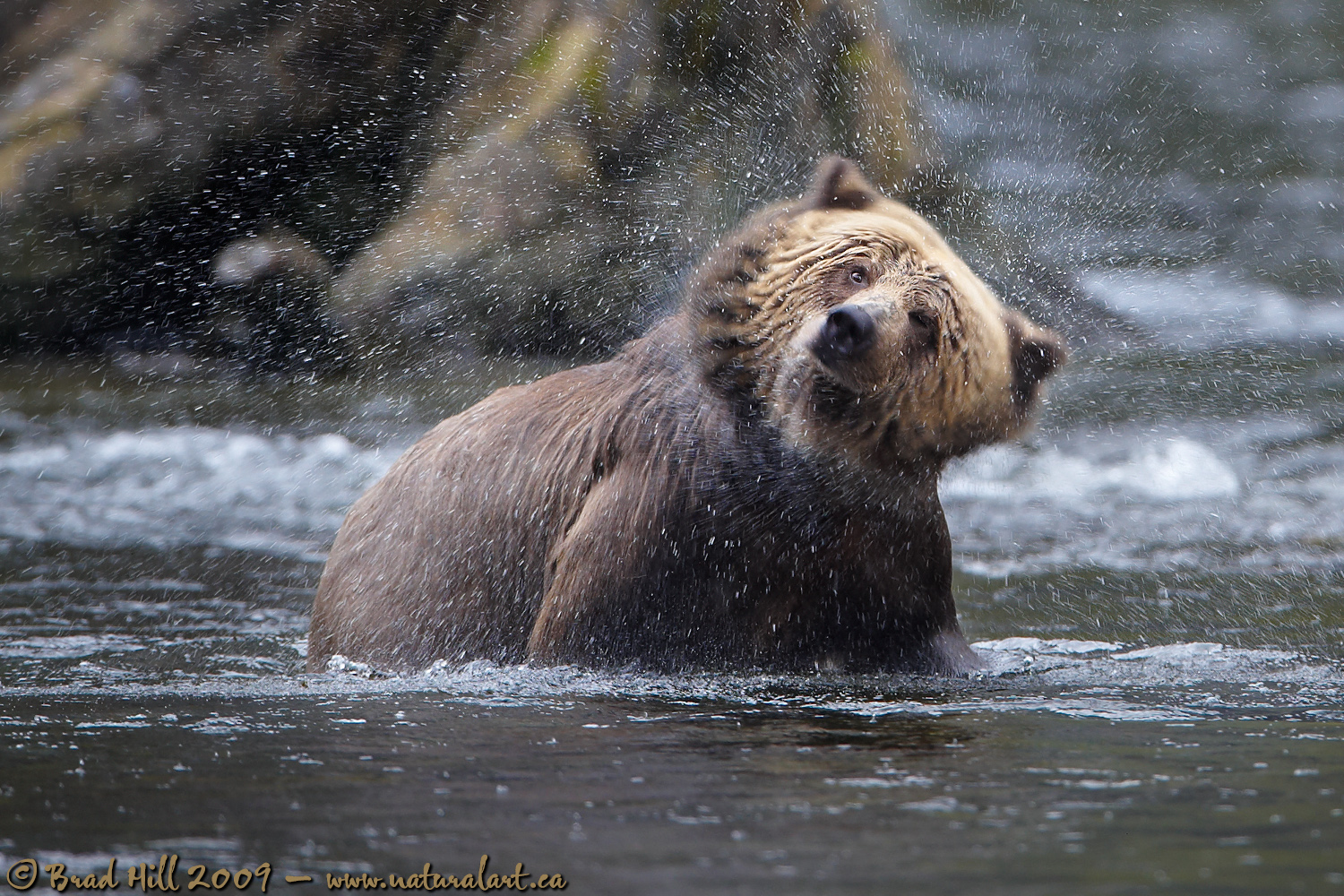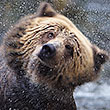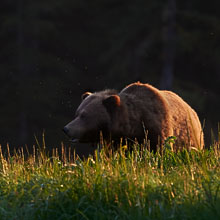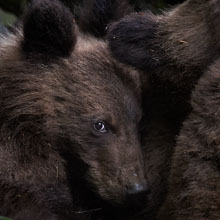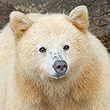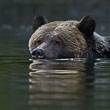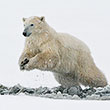Availability: Undetermined - Enquiries?
In the Field
I'm Still Watching You! Great Bear Rainforest (northern BC coast). October 11, 2008.
Put a Brown (or Grizzly) Bear in water and before long they'll vigourously shake their head. This bear had been dunking its head in search of salmon and pretty much every time it raised its head it shook. I didn't know until I looked at this image (and a host of others of the same bear) that even when shaking the bear kept its eye(s) on me. Could it actually see anything while shaking? I have no idea...but there must have been some reason that it pointed its head in our direction while shaking.
Like with many other bear behaviours, it's not that unusual to see a fishing bear shake its head. However, effectively capturing the act on film or your digital sensor is another matter. To begin with, you have to be ready - while the behaviour frequently occurs, it only last a second or two and is easy to miss. In most cases you'll likely be capturing the action with at least a moderately long telephoto lens, so you also have to decide which part of the bear to focus on. I normally try to focus on the centre of rotation of the shake (it's the slowest moving part of the shake and thus the easiest part of the action to freeze), which is commonly the eye. Shutter speed? That's a creative decision that's up to the photographer to make. I personally prefer to choose a shutter speed that blurs SOME of the action but still allows you to freeze other parts of the action (in this case the eye and forehead of the bear). It's my experience that this is usually best accomplished using a shutter speed of ABOUT 1/250s. Bear in mind (pun intended) that the shutter speed that will produce the blur/freeze effect will be partly dependent on how much of the viewfinder's frame the subject occupies - at very close distances (and thus with the subject filling the bulk of the frame) you will need much faster shutter speeds than if the subject is small in your viewfinder. Ultimately the issue comes down to the following question: "How many pixels will the moving parts of the subject cover per unit time?" If few pixels are covered then your shutter speed needn't be too fast; if many pixels are covered then you require a much higher speed to freeze the action.
Behind the Camera
I'm Still Watching You! Great Bear Rainforest (northern BC coast). October 11, 2008.
Digital Capture; Compressed RAW (NEF) 14-bit format; ISO 640.
Nikon D3 with AF-S Nikkor 600mm f/4G IF-ED II VR lens supported on Gitzo 1348 carbon fibre tripod with Wimberley head. VR turned to "On" and in "Normal" mode. Autofocus set to M/a mode.
1/250s @ f5; -0.3 stop compensation from matrix-metered exposure setting.
At the Computer
I'm Still Watching You! Great Bear Rainforest (northern BC coast). October 11, 2008.
RAW Conversion to 16-bit TIFF, including first-pass/capture sharpening, white balance adjustment and slight highlight recovery adjustment using Phase One's Capture One Pro 4.5. Multiple RAW conversions (2 at different exposure settings: -0.44 stops for foreground water and background, +0.5 stops for bear's head).
Further digital corrections on 16-bit TIFF file using Adobe's Photoshop CS4. Adjustments included compositing and masking of both exposure versions, selective colour satuation, selective curves adjustment and selective sharpening for web output.
Conservation
I'm Still Watching You! Great Bear Rainforest (northern BC coast). October 11, 2008.
Ten percent of the revenue generated by this image will be donated to Raincoast*.
Species Status in Canada**: Special Concern (May 2002).
While Grizzly Bears (Ursus arctos) are not technically listed as "Endangered" in Canada, they have been extirpated from most of their historical range. Grizzly Bears are far more sensitive to intrusion/disturbance in their habitat than are Black Bears and are being increasingly forced into marginal habitat by human encroachment. The Great Bear Rainforest along the central and northern coast of British Columbia is one of the last strongholds of the Grizzly Bear in Canada, and even this population is coming under increasing pressure.
On December 18, 2017 the government of British Columbia banned grizzly hunting across the entire province. This major conservation victory came after decades of tireless work by many dedicated conservationists and ecologists and, most importantly, it reflects the opinion of the vast majority of British Columbians. And, it means that AT LEAST while the current government remains in power grizzlies are finally "safe" in British Columbia.
Now that we've at least temporarily won the battle to save grizzlies in BC, it's time to re-focus our efforts toward protecting ALL of BC's carnivores, including Gray Wolves, Black Bears, Cougars, Wolverines, and more! Simply put, there are no ecological, economic, or ethical arguments supporting the trophy hunting of carnivores.
In a great first step towards ending the hunting of carnivores throughout BC the Raincoast Conservation Foundation has developed a program designed to protect ALL carnivores within the Great Bear Rainforest. Details about this program can be found on this page on Raincoast's website. Check it out and, better yet, make a donation to help Raincoast purchase the remaining commercial hunting tenures in the Great Bear!
*The Raincoast Conservation Society (and Foundation) is an effective and efficient organization that has been fighting for protection of this unique habitat. If you are looking for a meaningful way to contribute to the conservation of this amazing ecosystem, Raincoast will provide maximal "bang" for your conservation dollars.
**as determined by COSEWIC: The Committee on the Status of Endangered Wildlife in Canada












